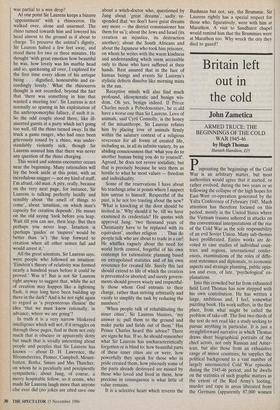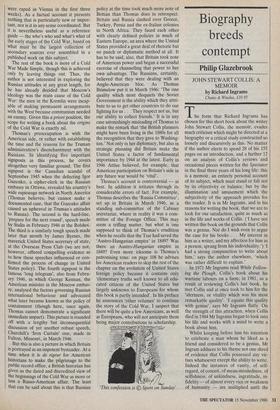Britain left
out in the cold
John Zametica
ARMED TRUCE: THE BEGINNINGS OF THE COLD WAR 1945-46 by Hugh Thomas
Hamish Hamilton, fly
Pinpointing the beginnings of the Cold War is an arbitrary matter, but most authorities would agree that it started, or rather evolved, during the two years or so following the collapse of the high hopes for East-West co-operation generated by the Yalta Conference of February 1945. Much attention has therefore focused on this period, mostly in the United States where the Vietnam trauma ushered in attacks on the conventional interpretations of the rise of the Cold War as the sole responsibility of an evil Soviet Union. Many sub-themes have proliferated. Entire works are de- voted to case studies of individual coun- tries and regions, international confer- ences, examinations of the roles of diffe- rent statesmen and diplomats, to economic aspects and strategic planning, public opin- ion and even, of late, 'psychological' ex- planations.
Into this crowded but far from exhausted field Lord Thomas has now stepped with his own contribution. He has written a large, ambitious and, I feel, somewhat puzzling book. His work suffers, in the first place, from what might be called the problem of take-off. The first two-thirds of the text do not read like a study seeking to pursue anything in particular. It is just a straightforward narrative in which Thomas draws short biographical portraits of the chief actors, not only Russian and Amer- ican, but also those from an exhaustive range of minor countries; he supplies the political background to a vast number of largely unconnected Cold War episodes during the 1945-46 period; and he dwells on the statistics of such graphic matters as the extent of the Red Army's looting, murder and rape in areas liberated from the Germans (apparently 87,000 women were raped in Vienna in the first three weeks). As a factual account it presents nothing that is particularly new or impor- tant, nor is it in any sense coordinated. But it is nevertheless useful as a reference guide — the who's who and what's what of the early stages of the Cold War, based on what must be the largest collection of secondary sources ever assembled in a published work on this subject.
The rest of the book is more of a Cold War Made Simple, though this is achieved only by leaving things out. Thus, the author is not interested in exploring the Russian attitudes at any great length, for he has already decided that Moscow's ideology was the main cause of the Cold War: the men in the Kremlin were incap- able of making permanent arrangements with the West because communism needed an enemy. Given this a priori position, the scope for writing a book about the origins of the Cold War is exactly nil.
Thomas's preoccupation is with the American side, or rather with establishing the time and the reasons for the Truman administration's disenchantment with the Russians. In identifying five important signposts in this process, he covers altogether very familiar ground. The first signpost is the Canadian scandal of September 1945 when the defecting Igor Guzenko, a cipher-clerk in the Russian embassy in Ottawa, revealed his country's wide espionage network in North America (Thomas believes, but cannot make a documented case, that the Guzenko affair caused an upheaval in Truman's attitudes to Russia). The second is the hard-line, `prepare for the next round', speech made by Stalin in February 1946 at the Bolshoi. The third is a similarly tough speech made later that month by James Byrnes, the maverick United States secretary of state, at the Overseas Press Club (we are not, however, offered compelling evidence as to how these speeches influenced or con- firmed the process of change in United States policy). The fourth signpost is the famous 'long telegram', also from Febru- ary 1946, in which George Kennan, the American minister in the Moscow embas- sy, analysed the factors governing Russian international behaviour and advocated what later became known as the policy of containment (though here, once again, Thomas cannot demonstrate a significant immediate impact). This picture is rounded off with a lengthy but inconsequential discussion of yet another robust speech, Churchill's 'Iron Curtain' one, made in Fulton, Missouri, in March 1946.
But this is also a picture in which Britain is portrayed as an impotent bystander. At a time when it is de rigeur for American historians to make the pilgrimage to the public record office, a British historian has given us the dated and discredited view of the beginnings of the Cold War as more or less a Russo-American affair. The least that can be said about this is that Russian policy at the time took much more note of Britian than Thomas does in retrospect. Britain and Russia clashed over Greece, Turkey, Persia and the ex-Italian colonies in North Africa. They faced each other with clearly defined policies in much of Eastern Europe, an area where the United States provided a great deal of rhetoric but no punch or diplomatic method at all. It has to be said, also, that Britain took note of American power and began a successful exercise of channelling that power to her own advantage. The Russians, certainly, believed that they were dealing with an Anglo-American bloc. As Thomas Brimelow put it in March 1946: 'The one quality which most disquiets the Soviet Government is the ability which they attri- bute to us to get other countries to do our fighting for us . . . They respect not us, but our ability to collect friends.' It is in any case astonishingly misleading of Thomas to make the remark that 'the British planners might have been living in the 1880s for all the recognition that they gave to Washing- ton.' Not only in her diplomacy, but also in strategic planning did Britain make the United States a factor of fundamental importance by 1944 at the latest. Early in 1946 Attlee believed, for example, that American participation on Britain's side in any future war would be 'vital'.
Thomas's account is controversial — at best. In addition it irritates through its considerable errors of fact. For example, Thomas describes the 'Russia Committee', set up in Britain in March 1946, as a standing sub-committee of the Cabinet secretariat, where in reality it was a com- mittee of the Foreign Office. This may seem a trifling matter, but what is one supposed to think of Thomas's erudition when he recalls that the Tsar had saved the 'Austro-Hungarian empire' in 1849? Was there an Austro-Hungarian empire in 1849? Even more irksome is Thomas's patronising tone: on page 108 he advises his American readers to skip the rest of the chapter on the evolution of United States foreign policy because it contains only `elementary truths well known to all edu- cated citizens of the United States but largely unknown to Europeans for whom this book is partly intended'. In his preface he announces 'other volumes' to continue the story of the Cold War. I suspect that there will be quite a few Americans, as well as Europeans, who will not anticipate them being major contributions to scholarship.
This confession is © Sport on ▪ Su• nday'



































































 Previous page
Previous page